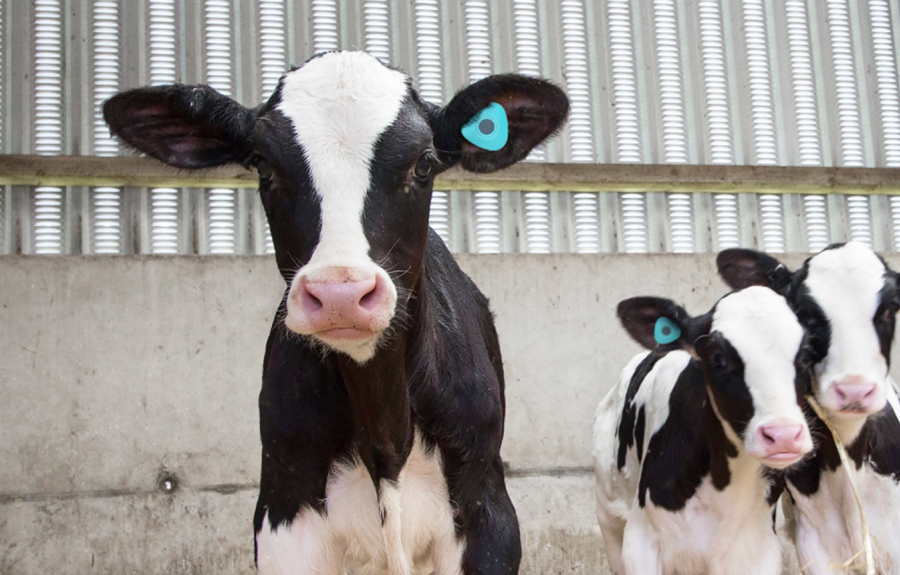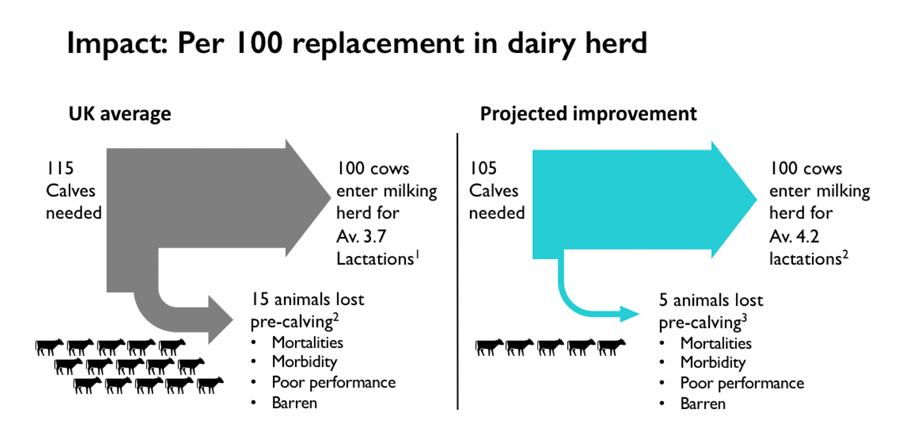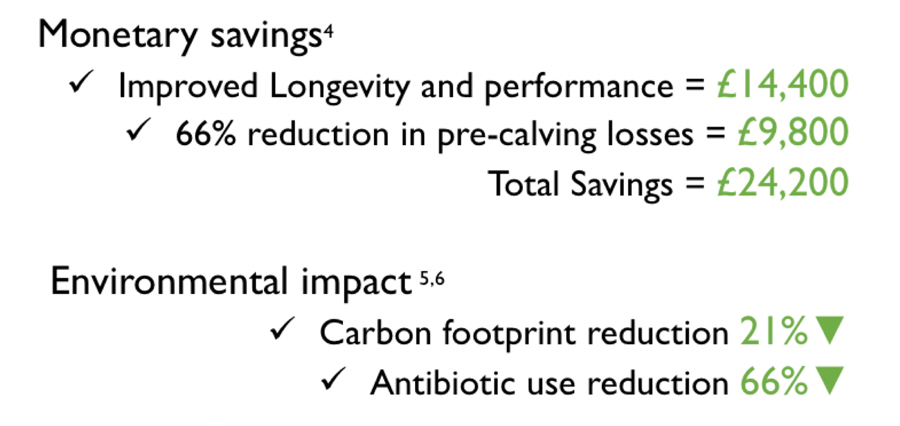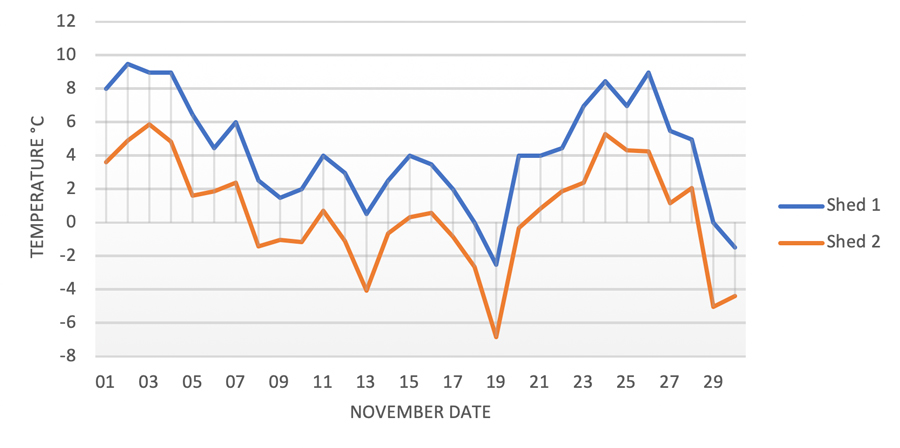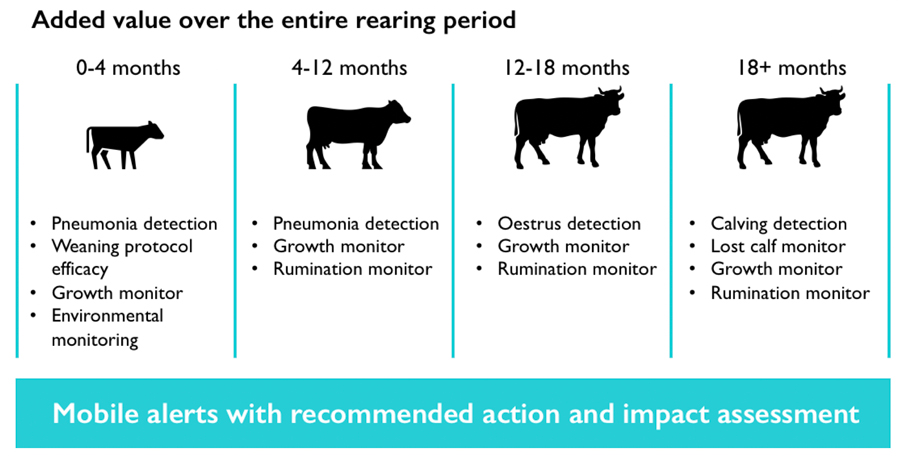Healthy heifer: Hitting 24 months
9th July 2020
Youngstock rearing is one of the top three costs for most dairy businesses, but perhaps a better way is to look at it as an investment in your future. This is one area where the returns can be significant and long-term.
Youngstock rearing is one of the top three costs for most dairy businesses, but perhaps a better way is to look at it as an investment in your future. This is one area where the returns can be significant and long-term. One of the largest proven benefits can be from improving age at first calving, but the UK average is still 28 months, well under the recommended 24 months.
Feeding and nutrition is vital for the growth of young heifers. Well-grown heifers will produce more milk, compete better with mature cows and survive longer in the herd. Increasing the survival rate of young animals also boosts income and helps to improve the quality of the herd, whether it be by selling cows in milk or by putting more cows to beef semen.
To get the best performance from calves, you need to focus on three main areas: health, nutrition and environment.
For every 100 replacement animals to reach the herd, 15 potential milking cows never make it. The main reasons are disease, poor growth and poor fertility. Smartbell works to improve both health and environment, to help generate 66 per cent better results, similar to the best rearers.
Smartbell has developed an eartag that can detect the early signs of respiratory disease and help to give early and effective intervention. It is estimated that over 30 per cent of dairy calves are affected in the first year of life. Pneumonia can cause death and even if the calf survives, there is often long-term damage to the lungs. This has a significant impact on milk production and fertility for the rest of its life, but early intervention minimises the damage and helps to reduce the spread of disease within calf groups.
Recognising the early signs of disease is a valuable skill for any team member, but lack of time and expertise can lead to shortcomings in this area. Did you know that the top 10 per cent of calf rearers pick up signs of calves that are falling sick on average three days earlier than the average? Smartbell provides an early warning system that helps you achieve 66 per cent better results, similar to the best rearers, making sure attention is focused on those calves who really need it.
*Above figure is an estimation for a 100-replacement dairy herd. Specific savings may vary farm to farm
Would you like a completely free, no obligations assessment for how much the impact could be on your farm? Sign up for your free assessment. Smartbell will ask you a few simple questions and build a customised report for you. For more information, visit www.wellcalf.com
Environment
Calves have a relatively small range of temperatures at which they feel comfortable in the first few weeks, so it is important to know if they need extra help in this early stage. On sunny days, some sheltered corners can easily get over 25°C. Conversely, if pens are exposed to a draft then temperature at night can drop well below 10°C, even during summer. Knowing your conditions can help to adapt the housing – it could be that more shade is needed in summer, or that calf jackets help in winter to keep the young animals in top condition.
We use temperature and humidity sensors to monitor conditions within the buildings. It can be surprising how much variation there is between different buildings on the same farm, or even within one shed!
*Above figure shows high variation between two sheds in a single calf rearing unit
Seen above, a group of 50 calves reared in shed 2 has an additional feed cost of £115 compared to shed 1 – money that could be saved with some simple changes.
Growth and fertility
In order to serve animals at the right time, they need to be reaching 56 per cent of their final weight by 13 months and to have reached puberty. The only way to be certain of growth performance is through measuring your animals. Using weigh scales or measuring height at the withers are reliable methods, helping to show current performance against expected growth. This can flag up any problems well in advance, permitting intervention to put your animals back on track through diet change or other techniques. By entering the latest weight information into the Smartbell app, you can see growth trends and highlight any problems for individuals at an early stage.
Long-term gains
A reduction in AFC by two months would result in an immediate gain of £180 per replacement animal, through earlier entry into the milking herd. The increase in survival rates from 85 per cent to 95 per cent for heifer calves to get into the milking herd would result in savings of £31 per animal, as well as giving farmers the options to breed more beef calves to add extra value.
The really big gains are in improving the long-term health and fertility of the cows. This will boost yields and as a side benefit, by increasing the number of lactations in the herd from 3.7 (the current UK average) to 4.2, there is a saving of £54 per milking animal per year.
Smartbell for beef calf rearing
The company says its products offer a range of benefits to improve the profitability of beef calf rearing. Early detection and intervention for disease occurrence translated to a productivity gain of up to183kg, representing a value of £221/animal between top 10 per cent and bottom 10 per cent of farms.
Call for trials
Smartbell specialises in calf monitoring and disease detection, for dairy and beef. Sign-up now for a trial, and you may be eligible to win one of the five free trial giveaways for this autumn! For more information, please go to www.wellcalf.com or email contact@smartbell.io.
References:
1 AHDB Dairy Performance 2017/18 [link]
2 Mortality in Holstein-Friesian calves and replacement heifers, in relation to body weight and IGF-I concentration. Paper by J.S. Brickell [link]
3 Target system performance based on expanding early results achieved in calves to heifer rearing and AHDB Heifer rearing guidelines [link]
4 An empirical analysis of the cost of rearing dairy heifers from birth to first calving and the time taken to repay these costs. Paper by A.C. Boulton [link]
5 Based on improvement in calf from birth to herd from 85 to 95% and improved longevity resulting in replacement rate going from 27% to 24%
6 Monitoring of activity and feeding behaviour for early detection of respiratory disease in pre-weaned calves [link]
